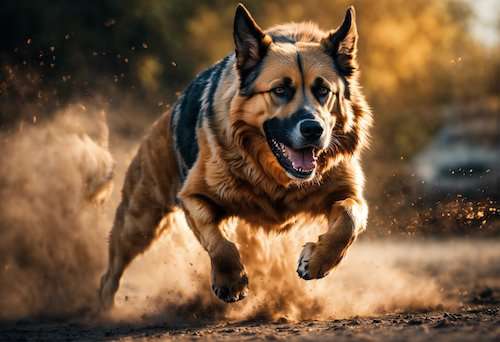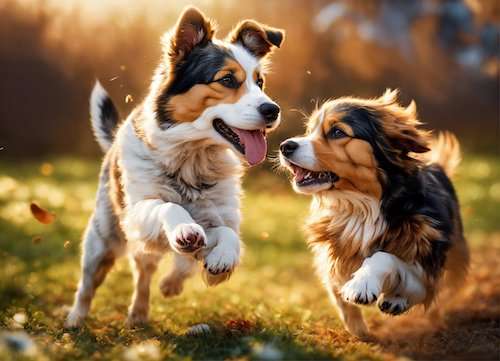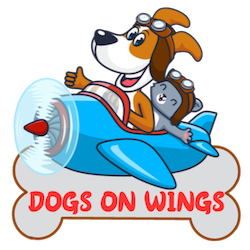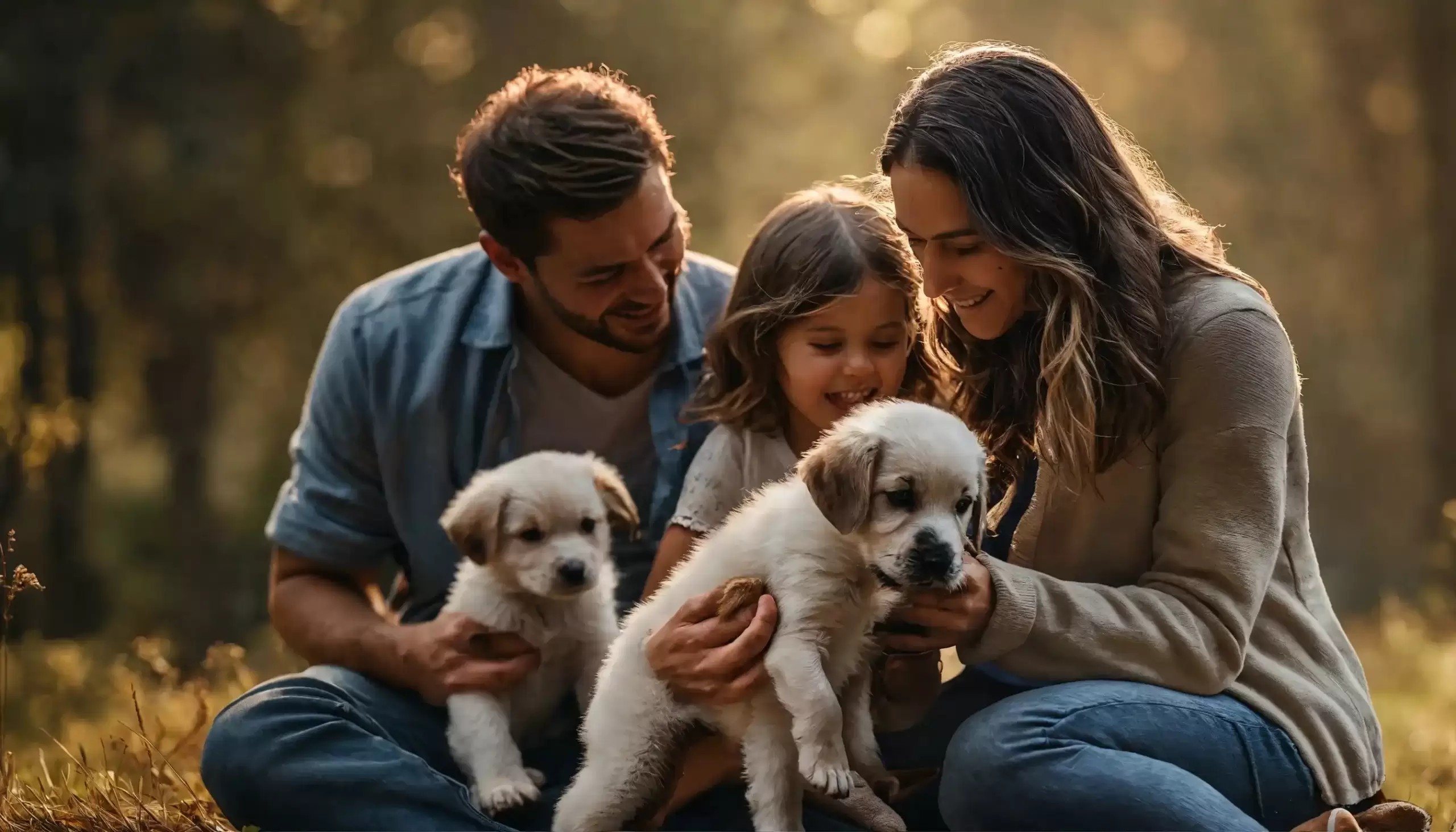Understanding dog behavior is essential for strengthening the relationship between you and your dog. Every movement, every glance, tells a story and reveals deep emotions that often go unnoticed. Therefore, knowing how to decipher these signals can be the key to a happier coexistence.
Whether you are a first-time dog owner or a dog lover, it’s essential to understand the details of what your furry friend is trying to communicate. From a tail wagging with joy to a look of insecurity, every behavior is an invitation to connect.
Let’s explore together these little big messages that our four-legged friends send us and discover how this can transform your relationship with them—check it out!

Dog’s Emotions
Dogs are remarkable creatures capable of a rich tapestry of emotions, often mirroring the depth and range found in their human counterparts. Understanding dog behavior can enhance our connection with them.
- Happiness radiates through the joyful rhythm of a wagging tail, an exuberant display that signifies delight and excitement. Contentment is expressed through a relaxed body posture, a sigh of satisfaction, or the gentle hum of a contented dog.
- Love and affection manifest in tender moments of cuddling, seeking physical closeness, and the rhythmic cadence of licking as a gesture of bonding. Fear unveils itself through trembling or shaking, seeking shelter, and wide-eyed expressions indicating distress.
- Anxiety may manifest in whining, pacing, or destructive behavior, reflecting inner turmoil. Excitement, an emotion palpable in bouncing movements and high-pitched barking, illustrates their anticipation and positive engagement.
- The spectrum of sadness or grief is embodied in lethargy, changes in eating habits, and mournful gazes that tug at the heartstrings of those who witness a dog’s emotional downturn. Curiosity fuels their exploratory nature, evident in a tilted head, sniffing, and a zest for discovering new scents and environments.
- Aggression, a protective instinct, may emerge with growling, snarling, or bared teeth, signaling discomfort or perceived threats. Jealousy, a complex emotion, is showcased through attention-seeking behaviors, whining, or pawing when they sense a diversion of affection.
These emotions collectively paint a nuanced portrait of canine complexity, emphasizing the need for empathetic understanding, responsible care, and unwavering companionship in the intricate dance between humans and their beloved dogs.
How Does My Dog Display Appeasement or “Submissive” Signals?
Naturally, dogs communicate a myriad of emotions through subtle signals, and appeasement or submissive dog behavior are integral aspects of their social language.
One common display of submission is the lowered body posture, where a dog might crouch or lower its front body, demonstrating deference to a more dominant presence. Averting eye contact is another appeasement signal, as direct stares can be perceived as confrontational or challenging in the canine world.
These adorable creatures may also exhibit a “lip lick,” a quick flick of the tongue across the nose or lips, conveying their intent to ease tension and avoid conflict. Paw lifting, where a dog gently raises a front paw, serves as a conciliatory gesture, suggesting a desire for harmony.
Rolling over or exposing the belly is a vulnerable position that signifies submission and trust, as the belly is a sensitive area. Yawning, even when not tired, is another appeasement signal, diffusing potential stress or discomfort.
Additionally, dogs might engage in “soft” body language, with loose, wagging tails and ears held back, portraying a non-threatening demeanor. Sniffing the ground or engaging in displacement behaviors, like scratching or shaking off, are further indications of attempting to diffuse tension.
So, recognizing these appeasement signals is crucial for fostering positive interactions and maintaining a harmonious canine-human relationship based on mutual understanding and respect.
Why Does My Dog Look Guilty?
When your dog gives that guilty look, it’s often triggered by your reaction rather than an understanding of right or wrong. They are pretty perceptive to our body language, tone of voice, and facial expressions.
If they’ve done something that led to a negative response in the past, like chewing on your favorite shoes, they might associate that act with your disapproval.
When you catch them in the act or find the aftermath, your response can lead to submissive dog behavior, like a lowered body, avoiding eye contact, or flattened ears—things we interpret as guilt.
However, it’s crucial to remember that dogs don’t share our moral reasoning. They’re reacting to their immediate environment and your cues. So, what seems like guilt is more likely a learned response to the consequences of their actions rather than a deep understanding of right and wrong.
To navigate these situations well, patience, understanding, and positive reinforcement go a long way in fostering a strong and communicative bond between you and your furry friend.
Our Emotions Have an Impact
The influence of our emotions on dogs is substantial when compared to their own emotional responses. Canines are remarkably attuned to our emotional states, picking up on cues from our body language, tone of voice, and overall demeanor. If we’re cheerful, they often mirror that joy, wagging their tails and seeking interaction.
Conversely, if we’re upset or stressed, dogs may exhibit signs of concern or try to offer comfort. This strong emotional connection is a testament to the depth of the human-dog bond. Puppies don’t just coexist; they engage with our emotional world, responding with empathy and loyalty.
The Connection Dog and Human

The bond between dogs and people is an extraordinary connection that goes beyond mere companionship. This unique relationship is woven with threads of understanding, loyalty, and shared experiences.
Dogs, with their innate ability to interpret human emotions, become steadfast companions, offering comfort during challenging times and celebrating joyous moments with genuine enthusiasm. Our connection with them transcends verbal communication; it’s a silent, unspoken understanding that forms the foundation of a profound friendship.
The wag of a tail, the warmth of their presence, and the joy they express when we return home create a tapestry of connection. They tend to teach us about unconditional love, loyalty, and the beauty of living in the present moment.
As we reciprocate this connection through care, attention, and shared activities, the bond deepens, enriching our lives in ways that words often fail to capture.
In this extraordinary companionship, people find not just a pet but a confidant, a source of joy, and a friend who, without uttering a word, understands the language of the heart.
How Does a Dog Communicate With its Body?
Dogs are remarkably expressive creatures, and their primary mode of communication is through body language. A wagging tail can convey excitement or happiness, but it’s crucial to note that the speed, height, and direction of the wag provide nuanced information about their dog behavior.
Ears, like antennas, signal their emotional state perked ears denote attentiveness, while flattened ears may indicate fear or submission. Eye contact is another vital element; direct gaze can express confidence, while averting their eyes might signify discomfort or submission.
The overall body posture speaks volumes, with a relaxed stance indicating comfort and contentment, and a tense posture signaling stress or fear. Puppies also use vocalizations, such as barking or whining, to communicate specific needs or emotions.
When we understand these cues, it allows us to navigate our canine companions’ emotional landscape, fostering a deeper connection and ensuring that our interactions are attuned to their feelings and needs.
Aggressive or Threatened Dog Behavior
When a dog displays aggressive or threatened behavior, it’s important to discern the underlying signals to facilitate effective communication and ensure a safe environment.
Aggression in dogs may manifest through growling, baring teeth, or even snapping, often rooted in feelings of fear, anxiety, or a perceived threat to their territory. Deciphering the accompanying body language is crucial; a tense body, raised hackles, and a direct stare indicate a dog feeling threatened.
To de-escalate the situation, it’s essential to avoid sudden movements and eye contact, providing the dog with space. Identifying and removing stressors whenever possible is key.
Seeking professional guidance is advisable, as aggression can stem from various factors, such as past trauma, lack of socialization, or underlying medical issues.
Employing patience, positive reinforcement, and a gradual approach aids in rebuilding trust and addressing the root causes of aggressive dog behavior. This ensures a safer and more harmonious relationship between dogs and their human companions.
How does My Dog Display Assertive, Aggressive, or Distance-increasing Signals?
Dogs utilize a diverse range of signals to communicate these emotions, and it’s crucial for owners to be attuned to these nuanced cues. Assertive signals often involve confident body postures, such as standing tall, ears erect, and a steady gaze.

Aggressive Dog Behaviors May Include:
- Bared teeth
- Raised hackles
- Tense body stance
This signals indicate a potential threat. When a dog seeks increased distance, they might exhibit behaviors like lip licking, turning away, or even growling as a clear warning.
Transitioning from assertive to aggressive signals often involves clear warning signs, like a shift in facial expression or an increase in the intensity of vocalizations.
Recognizing and appropriately responding to these signals requires a combination of knowledge, patience, and positive reinforcement, fostering a harmonious relationship between dogs and their human companions.
Friendly Dog Behavior and Communication
A Friendly dog behavior is a delightful testament to the inherent companionship dogs bring to our lives. When a dog exhibits friendliness, their body language exudes warmth, often showcased through a wagging tail, perked ears, and a relaxed posture.
Canine communication extends beyond barks and includes a repertoire of friendly gestures like playful bounces, inviting nudges, and the classic “puppy eyes” look.
Dogs Can Express:
- Joy
- Affection
- Desire for social interaction
Pet owners play a pivotal role in reinforcing and reciprocating this friendly dog behavior. Offering praise, treats, or a good belly rub establishes positive associations, further strengthening the human-dog bond.
It’s essential to respect a dog’s comfort zones, allowing them to initiate contact and respecting their signals. Regular socialization, both with humans and fellow dogs, fosters a well-rounded and friendly demeanor.
Understanding and appreciating these friendly communication cues enriches the unique and heartwarming connection between dogs and their human companions, creating a harmonious environment full of tail wags and shared joy.
Whining With Specific Behaviors
Whining, accompanied by specific behaviors, is a nuanced form of canine communication that necessitates a keen understanding from dog owners. When a dog whines, it’s crucial to discern the context and associated actions.
Transitioning from one behavior to another, a dog might initially whine to convey anticipation and then exhibit joyful tail wags or play bows. Alternatively, if discomfort or fear underlies the whining, the dog might transition into submissive postures, like cowering or avoiding eye contact.
Responding appropriately to these nuanced signals involves a mix of empathy, observation, and positive reinforcement, establishing trust and a strong communicative bond between humans and their canine companions.
Stressed or Sleepy? Yawning Can Mean Both
To understand whether your pet is stressed or simply sleepy involves observing their dog behavior, and interestingly, yawning can serve as a dual-purpose signal. While people commonly associate yawning with tiredness, dogs may yawn in response to stress or anxiety.
Identifying the context is essential in interpreting this behavior. If your dog has been engaged in a high-energy activity and yawns, it’s likely a sign of fatigue.
On the other hand, if you observe yawning in situations that may trigger unease, such as during a vet visit or in crowded environments, it could indicate stress. Additionally, pay attention to accompanying signs like tense body language, lip licking, or avoiding eye contact, which may further indicate stress.
As pet parents, it’s crucial to consider the overall context and your dog’s specific cues to accurately decipher whether the yawn signals a need for rest or if it’s a response to a stressful situation. By understanding these subtle nuances, you can better respond to your dog’s needs and contribute to their overall well-being.
What is ‘Normal’ Dog Behaviour?

Generally, a normal dog behavior includes a mix of playfulness, curiosity, and social interaction. Although, Dogs exhibit a wide range of behaviors, so what is considered normal can vary based on factors such as breed, age, and individual personality.
They may bark to communicate, wag their tails to express happiness, and exhibit excitement during play.
Chewing, digging, and sniffing are often natural behaviors that fulfill their instincts. It’s normal for dogs to establish a routine, showing eagerness during mealtimes and displaying a sense of comfort in their designated sleeping areas.
Social breeds may seek interaction with people or other dogs, while more independent breeds might appreciate some alone time. It’s crucial to observe your dog’s behavior over time, considering any changes or signs of distress. Regular exercise and mental stimulation contribute to a healthy and well-balanced dog.
Overall, embracing the diversity of dog behavior while ensuring their well-being and happiness is key to fostering a harmonious relationship.
Understanding Your Dogs Fussing Behavior
Fussiness in dogs can manifest in various ways, such as being picky about food, showing reluctance to certain activities, or displaying sensitivity to specific environments. It’s crucial for pet owners to discern whether fussiness is a temporary preference or a sign of discomfort or anxiety.
Some dogs may have specific tastes, while others might be signaling underlying health issues. Observing their reactions to different stimuli, foods, or situations helps identify triggers for fussiness. Providing a balanced and nutritious diet tailored to their preferences can often address selective eating habits.
Positive reinforcement, such as praise or treats, can encourage desired conduct and help overcome aversions. Gradual exposure to new experiences or environments, paired with positive associations, aids in reducing fussiness related to anxiety.
Consistency in training and offering a secure and comfortable space further supports a dog’s confidence and reduces overall fussiness. In essence, addressing fussy dog behaviour involves a nuanced understanding of individual preferences, potential triggers, and a compassionate, tailored approach to create a positive and stress-free environment for the furry companion.
Conclusion About Dog Behavior
This comprehensive guide unravels the multifaceted aspects of canine behavior, providing valuable insights into decoding dogs body language, building trust through positive reinforcement, implementing effective puppy socialization techniques, understanding the pivotal role of nutrition, and addressing the challenge of separation anxiety.
Navigating the intricate landscape of dog behavior is a journey that every dog owner, whether a novice or seasoned enthusiast, embarks upon to cultivate a harmonious relationship with their furry companion.

